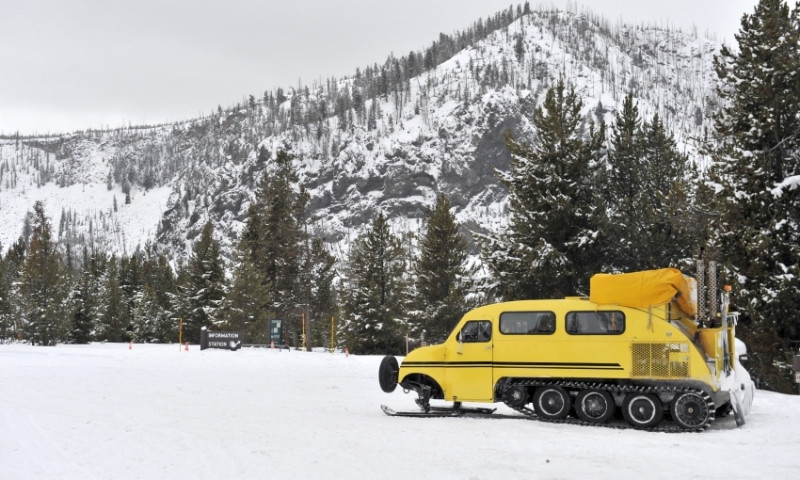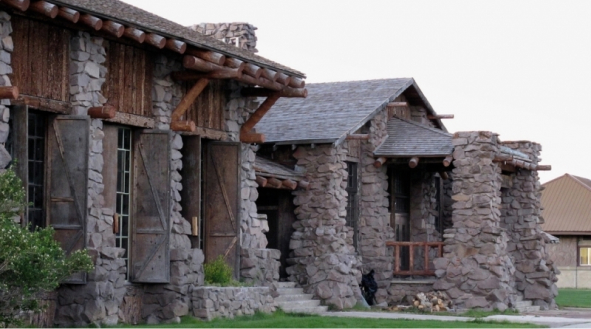Be sure to check out our Winter Guided Tours page!
Even though summer may be the traditional time to travel and explore Yellowstone National Park, winter trips here hold an allure all of their own. Steaming hot springs surrounded by cold winter air, snow-covered bison lying in huge herds and the magic that winter casts over a landscape make Yellowstone in the winter a place you won't forget.
Before you pack your bags and head out the door, here are a few things you should know.
Seasonal Road Closures
Twice every year, most of the entrances to and roads within Yellowstone National Park close. All roads close in mid-November with the exception of the North and Northeast entrances and the road which links them. In mid-December the west entrance opens to over snow vehicles (snowcoaches and snowmobiles). Entrances and roads close again in late March so that roads can be plowed and the can prepare for summer. Entrances and roads begin reopening in mid-April. See the complete schedule here.
Getting to Yellowstone National Park
How you get to Yellowstone National Park is largely determined by which entrance you plan on using and what you plan on doing while there. Here's a quick rundown of nearby airports and ground transportation for each entrance.
If you drive to Yellowstone National Park or rent a car at one of the local airports (all airports listed here have car rentals), be aware that winter storms may shut down roads or make driving hazardous.
Having winter snow tires and chains is always advised, and may be required on some roads.
- North Entrance
The North Entrance is located in Gardiner, Montana, along US-89. The closest airports are in Bozeman (about two hours away), Butte (just over 3 hours) and Billings, MT (about 3 hours and 15 minutes). Shuttles or taxis from Bozeman to Gardiner run during winter months. From the North Entrance you can drive into the park (the road between the North and Northeast Entrances is open to vehicles year round) and as far as Cooke City. - Northeast Entrance
The Northeast Entrance is just outside of Cooke City and Silver Gate, MT. Note that the road east of Cooke City closes from mid-October through late May so the only way to access the Northeast Entrance is via the North Entrance. - East Entrance
The East Entrance is located along US-16/US-20/US-14, 50 miles west of Cody, WY. The closest airports are in Cody, WY (just under1.5 hours away) and Billings, MT (4 hours). From the East Entrance you can only enter the park on an over-snow vehicle tour. - South Entrance
The South Entrance is just north of Grand Teton National Park and Jackson, WY, along US-89/US-26. The closest airports are in Jackson, WY (1.5 hours away) and Idaho Falls, ID (3 hours and 45 minutes). To access the park from the south, you can join a snowcoach or snowmobile tour or enter via cross country skis and snowshoes. - West Entrance
The West Entrance is located in West Yellowstone, MT, at the junction of US-20 and US-191/US-287. The closest airports are in Bozeman, MT (2 hours and 15 minutes away), Idaho Falls, ID (just under 3 hours away) and Butte, MT (3.5 hours away). Shuttles or taxis from Bozeman to West Yellowstone run during winter months. Perhaps the most popular winter entrance to the park, West Yellowstone offers access to the park via cross country ski and snowshoe trails as well as via snowcoach and snowmobile tours.
Where to Stay
There are lots of lodging options for a trip to Yellowstone National Park. If you want to stay inside the park, two concessionaire-operated lodges (Mammoth Hotel and Old Faithful Snow Lodge) stay open during the winter, but most people end up staying at one of the entrance towns (Gardiner, Cooke City/Silver Gate or West Yellowstone, MT) or one of the nearby towns (Bozeman, MT or Cody or Jackson, WY).
If you want to rough it and steer clear of hotels and lodges, Mammoth Campground is the only campground in Yellowstone National Park open during the winter. Backcountry winter camping (brrr) is also allowed, but permits are mandatory.
Seeing Yellowstone in the Winter
During winter months, Yellowstone National Park is covered with snow and ice and the park becomes a winter paradise for animals and people alike. While most of the park roads are closed to cars, the road from the North Entrance to the Northeast Entrance (52 miles) is kept clear and open year-round, as well as the .5 mile stretch from Mammoth Hot Springs to the Upper Terraces Park area.
Beginning in mid-December, the other Park entrances and main roads open (except for the East Entrance which opens a week later) for snowmobile and snowcoach travel, as well as other winter activities like cross-country skiing and snowshoeing.
Over-snow Vehicles
Snowmobiling through Yellowstone National Park is a popular winter adventure – its increasing popularity has led to recent reductions in daily limits of snowmobiles in the park. Limits aside, snowmobiling will continue to be one of the favorite ways to see Yellowstone's winter landscape, and with good reason.
If snowmobiles aren't in your bag of tricks, look into a snowcoach tour – these large, heated vans have had their tires swapped out with giant snow-tracks. Sit back in comfort as you roll through snow-covered forests on your way to Yellowstone highlights like Old Faithful, an even more spectacular in the winter.
Yellowstone National Park doesn't allow private, unguided snowmobile and snowcoach trips within the park, so be sure to go through a commercial tour company or hire a professional guide.
Cross-country skiing and snowshoeing
While big engines make some people happy, others come to Yellowstone National Park seeking the quiet peace and otherworldly silence that can only be found when the ground is covered with a blanket of white snow. Once the park opens for winter activities, cross-country skiers and snowshoers will find a plethora of trails and roads to explore, including overnight trips and longer one-way shuttle tours (commercial shuttles are available). While most trails are ungroomed, West Yellowstone at the West Entrance of Yellowstone National Park has an abundance of excellent skate and classic ski trails. There are also some groomed trails in the area around Old Faithful.
While guides for skiing and snowshoeing tours aren't required, they can help you get the most out of your visit by showing you some of the hidden gems in the Park and sharing natural history about local animals, geothermal activity, winter survival and more.
Plan Your Winter Vacation to Yellowstone:
- Browse Lodging near Yellowstone
- Search Transportation Options
- Take a Snow Coach Tour








